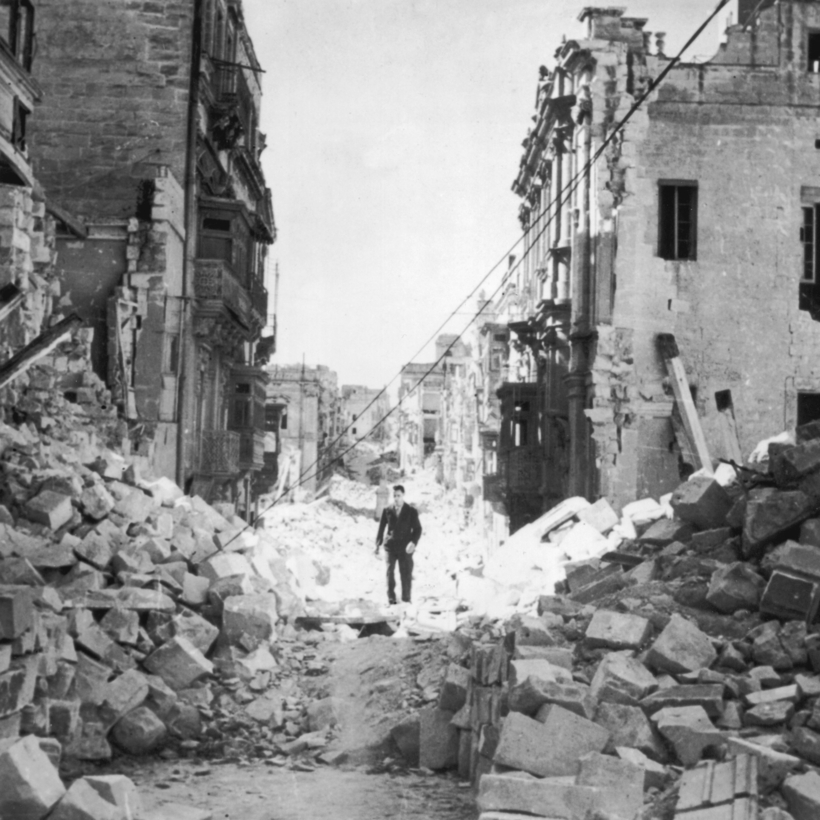Among the deluge of books published each year about the Second World War, accounts of naval convoys are few and far between. With the exception of the disastrous PQ17 convoy, whose grim fate in the Arctic Ocean has been often retold, these essential supply lines are generally deemed too unglamorous to explore. The very word “convoy” conjures an image of lumbering merchant ships ferrying food and supplies. It’s hardly the stuff to set the pulse racing.
The veteran historian Max Hastings wants to redress this misconception with his latest book, Operation Pedestal. Admittedly Pedestal was no ordinary convoy: it was a desperately needed lifeline to the beleaguered island of Malta, whose 300,000 starving inhabitants were close to surrender in the summer of 1942.
Yet there was another reason why Winston Churchill insisted that the “island fortress” must be saved at all costs. For him it was a matter of national and personal prestige. Britain had suffered a string of calamities — both Singapore and Tobruk had recently surrendered — and the embattled prime minister was facing political flak at home. What he needed, fast, was a morale-boosting victory.
However, saving Malta would not be easy; indeed it was to prove tantamount to suicide. The island lay more than 1,000 nautical miles from British-held Gibraltar and would require the 14-ship convoy to sail through seas infested with U-boats and high-speed torpedo craft. Another hazard came from the sky, which buzzed with 600 aircraft from the German Luftwaffe and Italian Regia Aeronautica.
The answer to these dangers, Churchill said, was to provide the convoy with the largest Royal Navy escort ever assembled. It was to consist of two battleships, four aircraft carriers, seven cruisers and 32 destroyers, as well as 100 aircraft, eight submarines and two minesweepers.
In the eyes of the merchant seamen heading to Malta, this formidable escort represented protection and reassurance. To the German Kreigsmarine and Luftwaffe and their Italian allies, of course, it offered an opportunity to wreak carnage on the Allies.
Saving Malta would not be easy; indeed it was to prove tantamount to suicide.
The extraordinary events that followed, between August 11 and 15, form the white-knuckle ride of Hastings’s gripping narrative. This is a high-octane adventure served up with torpedoes, Stuka dive-bombers and catastrophic U-boat attacks.
Those attacks were inevitable, given the extent to which German intelligence was eavesdropping on the mission. We tend to think of Bletchley Park as being the only player in the intelligence game, but, as Hastings shows, Hitler’s regional commander, Field Marshal Albert Kesselring, was fully aware of the fleet’s imminent departure from Gibraltar and used the knowledge to maximum advantage, deferring his opening move until the most opportune moment.
The first Axis attack was nevertheless an extremely lucky strike. Kapitänleutnant Helmut Rosenbaum had not hitherto distinguished himself as a U-boat commander, but raising the periscope on the morning of August 11, he could scarcely believe his good fortune. The giant British aircraft carrier Eagle was looming toward him, “looking like a giant matchbox on a pond”. He fired four torpedoes, all of which detonated against the hull and caused catastrophic damage. The stricken Eagle was doomed and sank within minutes, leaving 162 dead and many more thrashing around in the oily water. It was a devastating loss.
The second successful Axis attack, the next evening, was equally fortuitous. Renato Ferrini, commander of the submarine Axum, scored a hat trick with his salvo of torpedoes, striking the British flagship Nigeria, the Cairo and the tanker leviathan Ohio, whose oil and high-octane spirit were desperately needed to fuel Malta’s planes and warships. The heart-stirring story of this vessel and its crew sticks in the mind long after the cordite has dissipated.
A high-octane adventure served up with torpedoes, Stuka dive-bombers and catastrophic U-boat attacks.
Hastings’s four-day tableaux of bloodshed is not for the fainthearted. There’s the memorable account of Giacomo Metelline, gaping in horror when he went to the rescue of a fellow airman. “The pilot was clutching one of his own eyes, knocked out of his face by its impact upon his gunsight.” And there’s the seaman Hector Mackenzie, stunned by the sight “of a gaping hole in the wardroom’s wooden panelling, through which had been blasted the head of 25-year-old George Measures, his closest friend”.
Hastings argues that the Royal Navy was Britain’s outstanding fighting service of the Second World War, with a remarkable record of achievement. Yet his book is also an appreciation of the Allied merchantmen who found themselves unwilling participants in the combat.
As for winners and losers, Hastings ends his highly readable book with the apposite question of whether Operation Pedestal was worth the loss of 13 ships, 34 planes and some 500 men. The Axis powers declared themselves victorious after claiming so many scalps. Yet Hastings (among others) argues that the Malta convoy was an operational success for the Allies, tipping the balance in the central Mediterranean in favor of the British.
Moreover, the battle was a morale booster that raised the spirits of a nation sorely in need of good news. Churchill understood that this display of fortitude, although won at great cost, offered a glimpse of eventual victory.
That being so, it remains a grotesque injustice that, officers apart, so few of the Pedestal heroes — the gunners and the engineers who toiled below deck — got the awards they richly deserved.
Giles Milton is the author of numerous history books, including When Hitler Took Cocaine and Lenin Lost His Brain and Soldier, Sailor, Frogman, Spy

